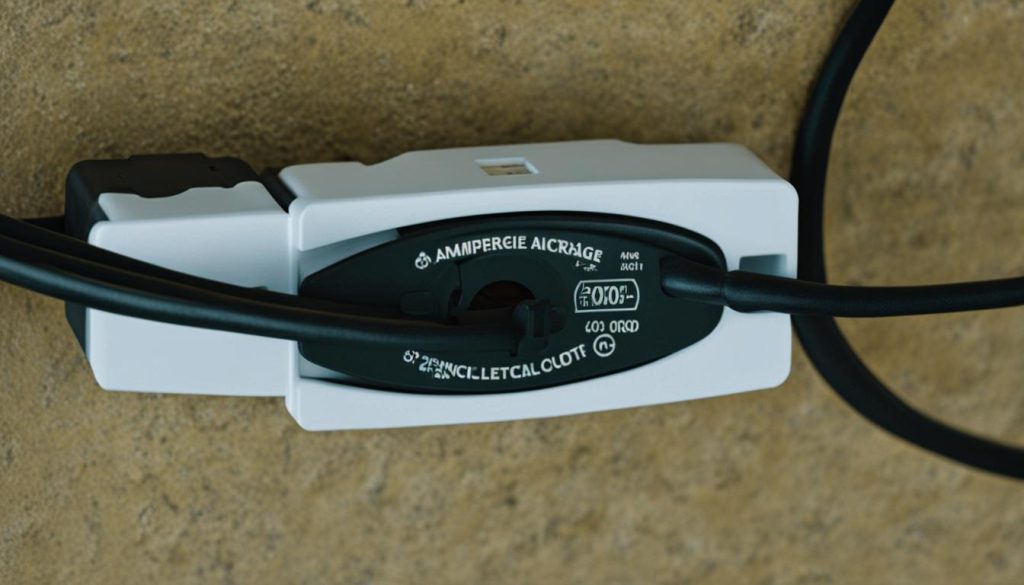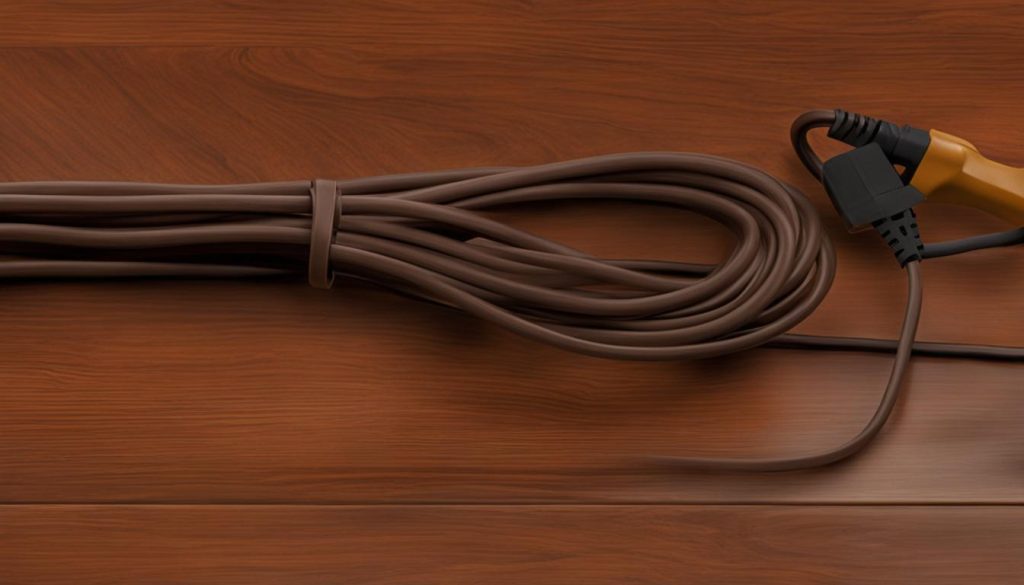When it comes to powering devices at a distance from the electrical outlet, a flat heavy duty extension cord is your go-to solution. These cords are not only convenient for homes and offices, but they also ensure your safety by reducing the risk of fire hazards.
Did you know that extension cords are responsible for around 50 deaths and 3,000 fires each year in the United States alone? That’s why it’s crucial to choose the best cord for your needs and take precautionary measures to prevent accidents.
Key Takeaways:
- Flat heavy duty extension cords offer a safe and convenient way to power devices at a distance from the electrical outlet.
- Consider factors like wire gauge, plug type, cord size, and amperage rating when choosing an extension cord.
- Thicker wire gauges and grounded plugs are important for delivering power and reducing the risk of fire and electrical shocks.
- Select the appropriate cord size and amperage rating based on your device’s requirements to avoid overheating and potential hazards.
- Flat plug extension cords have several benefits, including a low profile design and flexibility.
Understanding Wire Gauge and Plug Type
The wire gauge and plug type are crucial factors to consider when choosing a flat plug extension cord. Understanding these specifications will help ensure optimal power delivery and safety for your devices.
Wire Gauge
The wire gauge of an extension cord signifies the thickness of its wires, which directly impacts its power carrying capacity. The lower the gauge number, the thicker the wires and the greater the ability to deliver power consistently.
For example, common wire gauges for extension cords are 10, 12, 14, and 16. A cord with a lower gauge, such as 10, is suitable for heavy-duty power tools like circular saws, table saws, and chainsaws.
By choosing an extension cord with an appropriate wire gauge, you can ensure that your devices receive adequate power without the risk of overloading the cord or causing potential hazards.
Plug Type
In addition to wire gauge, the plug type is also vital for the safe operation of your extension cord. Extension cords can come with two or three prongs, and the presence of a third prong is crucial for grounding and reducing the risk of fire and electrical shocks.
Always opt for extension cords with a three-prong plug, as the third prong provides an additional level of safety by grounding the cord and preventing potential electrical hazards.
Understanding wire gauge and plug type will help you make an informed decision when selecting a flat plug extension cord, ensuring both efficiency and safety for your devices and electrical systems.
| Wire Gauge | Recommended Uses |
|---|---|
| 10 | Heavy-duty power tools |
| 12 | Power tools, air conditioners, heaters |
| 14 | Lawn mowers, small appliances |
| 16 | Lamps, electronics, low-power devices |
Choosing the Right Cord Size and Amperage Rating
When it comes to selecting the perfect extension cord for your needs, two important factors to consider are the cord size and amperage rating. These specifications play a crucial role in ensuring the safe and efficient delivery of power to your devices.
Cord size refers to the length of the extension cord. Choosing the right cord size is essential for optimizing power delivery. In general, shorter cords provide better power performance, especially for devices with higher power requirements. A longer cord can lead to voltage drops and decreased power output.
For example, if you have a power tool that requires a significant amount of electricity, it’s best to use a shorter extension cord to minimize power loss. On the other hand, if you’re only powering a small appliance or electronic device, a longer cord may be suitable.
Amperage rating is another critical consideration. Each device has a specific amperage and wattage requirement that must be matched by the extension cord’s rating. Using an extension cord with a lower amperage rating than required can lead to overheating, which poses a potential fire hazard.
It’s important to consider the amperage needs of your devices when choosing an extension cord. Most household appliances and tools have an amperage rating listed on their labels or in their user manuals. Make sure to match the amperage rating with that of the extension cord to avoid any safety risks.
Cord Size and Amperage Rating Recommendations
| Device Type | Recommended Cord Size | Amperage Rating |
|---|---|---|
| Small appliances | 16-gauge | 10A |
| Power tools | 12-gauge | 15A |
| Heavy-duty equipment | 10-gauge | 20A |

By choosing the right cord size and amperage rating, you can ensure a safe and reliable power supply to your devices. Remember to always check the manufacturer’s recommendations and consult an electrician if you have any doubts or questions.
Benefits and Advantages of Flat Plug Extension Cords
Flat plug extension cords offer several benefits and advantages. Their low profile design makes them convenient for use in tight spaces or areas with high foot traffic. They can be easily placed close to the ground, reducing the risk of tripping or accidents. Flat plug extension cords are also flexible, allowing for easy coiling and uncoiling. They are durable and robust, making them suitable for various applications, and are available in multi-outlet options for powering multiple devices.
| Advantages of Flat Plug Extension Cords |
|---|
| Low profile design |
| Reduces tripping and accidents |
| Flexible for easy coiling and uncoiling |
| Durable and robust |
| Multi-outlet options for powering multiple devices |

Safety Precautions and Tips for Using Flat Plug Extension Cords
When it comes to using flat plug extension cords, safety should always be a top priority. While these cords are generally safer than traditional rounded cords, it is important to follow proper precautions to prevent accidents and ensure the safe operation of your devices.
First and foremost, never use a damaged cord. If you notice any fraying, exposed wires, or other signs of wear and tear, replace the cord immediately. Using a damaged cord can lead to electrical shocks, fires, or other hazards.
Another important tip is to avoid using light-duty cords with high-power devices. These devices typically require a higher amperage and need a cord that can handle the load. Opt for a flat power cord with a higher amperage rating to ensure safe and reliable power delivery.
Additionally, it is recommended to use grounded extension cords with three prongs. The third prong provides an extra level of protection by grounding the cord, reducing the risk of electrical shocks and further enhancing safety.
Lastly, always choose the appropriate cord size and amperage rating based on your devices’ requirements. Using an undersized cord or a cord with a lower amperage rating than needed can result in overheating and potential hazards.
Remember, safety is paramount when using flat plug extension cords. Take the time to read and follow the instructions and guidelines provided with the cord. If you have any doubts or questions, consult a professional electrician who can provide expert advice on the correct cord length, usage, and any other safety considerations.
FAQ
Are flat heavy duty extension cords safe to use?
Yes, flat heavy duty extension cords are safe to use when used correctly and following safety precautions. It is essential to choose the right cord size, amperage rating, and plug type for your devices’ requirements.
What is the wire gauge of a flat heavy duty extension cord?
The wire gauge of a flat heavy duty extension cord determines its power delivery capacity. Common wire gauges for extension cords are 10, 12, 14, and 16. A lower gauge number indicates thicker wires and a greater capacity for delivering power.
What is the importance of the plug type in a flat heavy duty extension cord?
The plug type in a flat heavy duty extension cord is crucial for safety. Extension cords can have two or three prongs, with the third prong ensuring grounding and reducing the risk of fire and electrical shocks.
How do I choose the right cord size and amperage rating for my devices?
Choosing the right cord size and amperage rating for your devices is important to prevent overheating and potential hazards. Consider the power requirements of your devices and ensure that the extension cord’s cord size and amperage rating match those requirements.
What are the benefits of using flat plug extension cords?
Flat plug extension cords offer several benefits, including a low profile design that makes them convenient for use in tight spaces. They can be easily placed close to the ground, reducing the risk of tripping or accidents. Flat plug extension cords are also flexible and durable, making them suitable for various applications.
What safety precautions should I follow when using flat plug extension cords?
When using flat plug extension cords, it is important to follow safety precautions such as never using a damaged cord, avoiding the use of light-duty cords with high-power devices, and opting for grounded extension cords with three prongs for added safety. Choose the appropriate cord size and amperage rating based on your devices’ requirements and always read the instructions and guidelines provided with the cord.


